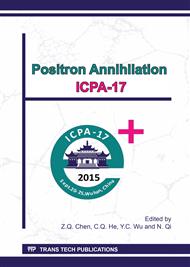p.41
p.46
p.53
p.57
p.61
p.65
p.71
p.75
p.80
Investigation of Non-Destructive Testing in Inner Cavity with Ant-Nest Structure Based on Positron Annihilation
Abstract:
The existing testing method could not accurately detect the defects in inner cavity with ant-nest structure in a part. The reasons are as follows: the shape of inner cavity is irregular, the distribution of wall thickness is uneven and the material composition is complex etc. A new testing method is proposed based on positron annihilation in this paper. The radionuclide solution is injected in inner cavity of the part and then produces positrons which would annihilate within 2 nanoseconds in the polylactide (PLA) material. The information of inner cavity is reflected by counting the γ photons produced by positron annihilation. The maximum likelihood estimation model (MLEM) with average compensation is established according to the detected γ photons. A 2D slice image sequence is obtained by order subset expectation maximization (OSEM) algorithm which solves the MLEM. The targets such as defects in the 2D slice image need to be enhanced by OTSU algorithm. A 3D image is reconstructed by the enhanced 2D slice image sequence which is used to the detection and location of the defects in inner cavity. Two experiments under different environment are conducted which aim at different ant-nest structure parts. The parts are made of different material and made by different manufacture process. A good testing result of the parts with complex shaped inner cavity could be obtained. The results would not change with the change of external temperature or magnetic field and the testing precision can reach to millimeter level.
Info:
Periodical:
Pages:
61-64
Citation:
Online since:
March 2017
Authors:
Keywords:
Price:
Сopyright:
© 2016 Trans Tech Publications Ltd. All Rights Reserved
Share:
Citation:


